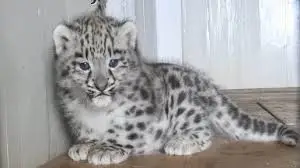Two more snow leopard cubs, a vulnerable species, born in Darjeeling Zoo

Darjeeling, a serene hill town in the Eastern Himalayas, is once again in the spotlight—this time for a heartening reason. Two snow leopard cubs, belonging to one of the most elusive and vulnerable species on Earth, were recently born at the Padmaja Naidu Himalayan Zoological Park (PNHZP). This milestone boosts not only the zoo’s legacy but also India’s broader conservation efforts for endangered high-altitude wildlife.
A Precious Addition to a Fragile Species
The snow leopard (Panthera uncia), often called the “ghost of the mountains,” is known for its solitary nature and powerful camouflage. It appears on the IUCN Red List as a vulnerable species. These majestic cats inhabit the high-altitude regions of Central and South Asia and face threats from habitat loss, poaching, and climate change.
The birth of two healthy cubs in April 2025 has sparked celebration. Their parents, Rare and Namka, are part of the zoo’s successful breeding program. Caretakers are currently raising the cubs at Togbey Danra, a secure Conservation Breeding Centre located 20 kilometers from Darjeeling.
Conservation Breeding: A Quiet Triumph
This isn’t the first time snow leopards have been born at PNHZP. The zoo launched its breeding program in 1985. Since then, it has seen 77 successful births—more than any other facility in the world.
So far in 2025, six cubs have been born at the zoo—the highest annual total in its history. Zoo officials credit decades of scientific planning, genetic tracking, and attentive animal care for this success.
The Central Zoo Authority of India oversees the program. PNHZP serves as the country’s lead institution for snow leopard breeding. It partners with other Indian zoos and international centers to maintain genetic diversity and prevent inbreeding.
A Special Home for the Cubs
Though not yet introduced to the public, the cubs are thriving in a setting that closely mimics their alpine habitat. Togbey Danra spans five hectares and features large, naturalistic enclosures of about 1,000 square meters each. These spaces allow snow leopards to roam, climb, and hide—behaviors vital to their development.
Zoo director Basavraj S. Holeyachi confirmed that staff monitor the cubs 24/7 using CCTV. Veterinary teams provide constant care and tailored nutrition. Their goal is to raise strong cubs with natural instincts—essential for future rewilding or breeding exchanges.
A Model for Global Conservation
The birth of these cubs has drawn praise from global wildlife groups. The World Association of Zoos and Aquariums (WAZA) commended the Darjeeling zoo for its long-standing success in snow leopard conservation.
PNHZP’s location plays a key role in its effectiveness. Perched at over 2,000 meters, the zoo mirrors the cold, rugged conditions of the snow leopard’s native range. These natural conditions make it easier to care for the species compared to lowland or urban zoos.
Looking Ahead: Names and Community Involvement
State Forest Minister Birbaha Hansda expressed joy over the cubs’ birth. She suggested that Chief Minister Mamata Banerjee might be invited to name them—a symbolic gesture aimed at sparking public interest.
The zoo also plans to launch interactive educational campaigns and virtual sessions for schools. These initiatives will help spread awareness about snow leopards and the importance of biodiversity.
Why Snow Leopards Matter
Beyond their striking appearance, snow leopards play a crucial role as apex predators. By hunting herbivores like mountain sheep and goats, they prevent overgrazing and help protect fragile alpine vegetation.
Saving snow leopards means protecting an entire ecosystem. Their presence signals a healthy, balanced environment in the high Himalayas—an area already under pressure from climate change and human expansion.






